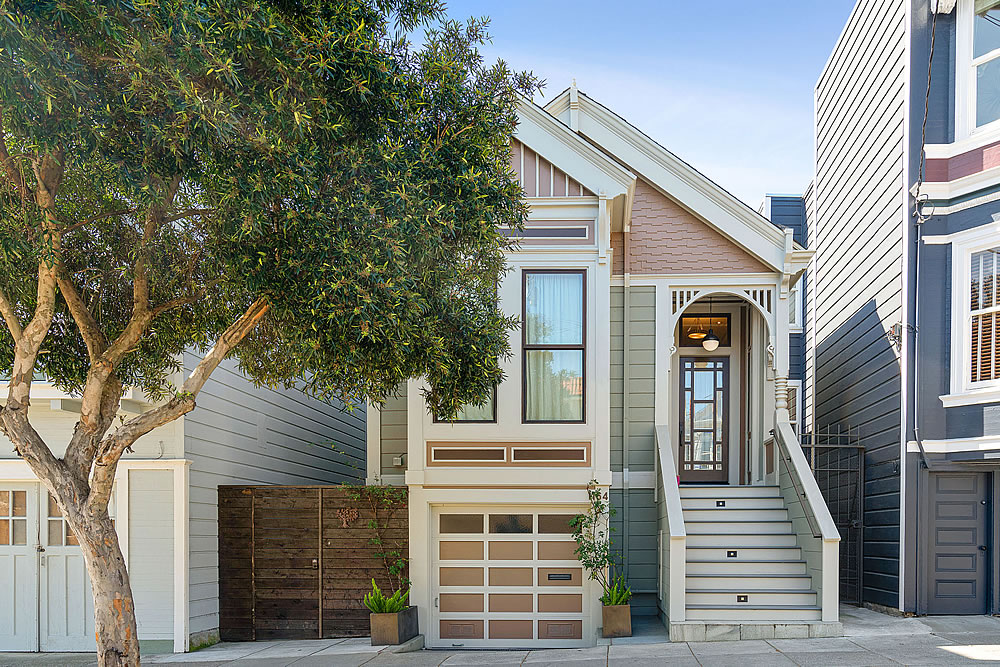Having been foreclosed upon, flipped and then completely remodeled to yield a nearly 3,000-square-foot Noe Valley home, with a “dramatic open floor plan,” four en-suite bedrooms and a two-car garage, 1164 Church Street sold for $2.45 million in October of 2013, as we outlined at the time.
Since further remodeled to add a fifth bedroom, the single-family home returned to the market in March of last year priced at $3.495 million, a sale at which would have represented total appreciation of 42.7 percent, or roughly 5.7 percent per year, since the fourth quarter of 2013.
And having been reduced to $3.145 million last July and then relisted new for $2.95 million last month, the re-sale of 1164 Church Street has now closed escrow with an “at asking” contract price of $2.95 million and only “29 days on the market” according to all industry stats, representing net appreciation of just 20.4 percent, or roughly 2.5 percent per year, for the remodeled single-family home since the third quarter of 2013, not accounting for the cost of adding the fifth bedroom.
The index for Bay Area (“San Francisco”) home values is up 66.2 percent over the same period of time.

Let me say this about that – that being comparing a San Francisco home’s performance against a Bay Area wide index of home appreciation. Apples to oranges and especially as this past year the other Bay Area counties have significantly outperformed San Francisco in appreciation. A trend likely to continue for the medium term.
That’s certainly something to keep in mind when you hear misreports of “San Francisco” home price appreciation.
Obviously the flipper in 2013 extracted more value from the property than was satisfied by the buyer at that time.
It also traded for 1.2 as a foreclosure in 2012 so as a generic one vs many data point, the performance over nearly the same time frame has been much better.
Except as outlined and linked above, the home was completely remodeled following its 2012-era sale (which included its expansion and addition of around 1,200 square feet of newly conditioned space).
Right, but that sort of detail is completely washed out in the index numbers, so picking one house and two dates is arbitrary whether you choose just before a remodel or just after. That’s worth keeping in mind.
Actually, as the aforementioned index excludes the gains from houses which have undergone major remodels between sales, and for good reason (see the confused comment above), that’s incorrect.
There are a lot of things that index doesn’t take into account ….
As long as it’s clear you think we should ignore the period where the home doubles in value and focus on the subsequent period of underperformance.
While we realize you’re trying to be snarky, that’s correct. Confusing capital improvements/investment with appreciation, particularly when calculating returns, is a fundamental mistake (as is your misunderstanding of the index at hand).
If the contemporaneous comments are to be believed, it was much more than just a remodel…
“The place is essentially uninhabitable in its current state. Describing it as “lovely” is like describing Saddam Hussein as “humanitarian” or Dick Cheney as “honest”… It would be worth much, much more as a vacant lot, because at least you wouldn’t have to deal with thr existing structure.”
“What Mike said. This place needs to be torn down. The stairs to the front door are so rotted out that you wonder if you are going to fall through. The rest of the house is just as bad.”
No one is telling you to ignore that 2012-2013 trade, but what was probably a near rebuild of a barely habitable property bought out of foreclosure isn’t really the same thing as market appreciation of a near-apple.
Spend a million bucks remodeling a home and then paint it in that puke-like color scheme? Granted, it’s very “old San Francisco.” But yuck.
I do applaud the developer for retaining, more or less, the historic architecture of the facade.